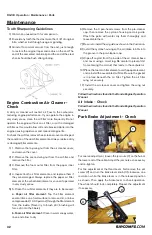
RG13II Operation • Maintenance • Parts
800.392.2686
19
Safety
that supplies energy to the equipment. In case of
mechanical energy, a block may be used to stop the
release of stored energy.
• A lock is to be placed on each energy source disconnect
or energy release block.
1. The lock is to be placed directly on the equipment if
provided with an integral locking device.
2. If there is no integral lockout device on the equipment,
securely attach an independently manufactured lockout
device on the equipment and then place the lock on the
lockout device.
3. If none of the above are possible, use the tag out
procedure.
• A tag to be secured to the lock indicating that the
equipment is not to be energized and who owns the lock.
• It should be safely tested and verified that the lockout
does prevent the release of energy.
Tag Out Procedure
• This procedure is to be used only if it is not reasonable
to use the lockout procedure.
• All affected persons are to be notified that the equipment
will be shut off and tagged out.
• All energy sources for the equipment should be identified.
• The equipment shall be shut off or otherwise de-
energized, being careful to de-energize all energy
sources. This includes all valves, switches, breakers, or
other controls that supplies energy to the equipment.
incase of mechanical energy, a block may be used to
stop the release of stored energy.
• Securely place a tag on each energy source disconnect
or energy release block.
Removal Procedure
• Lockout/tag out equipment must be removed by the
worker who placed it.
• Before the removal of a lockout/tag out the following
must be completed:
1. Removal of all non essential items.
2. Check to see that all workers and bystanders are
located in a safe position.
3. Inform all affected personnel.
• If a worker who applied the lockout/tag out is not present,
and his supervisor deems it necessary to energize the
equipment, the following must be done by the supervisor.
1. Make all reasonable effort to contact the worker who
placed the tag.
2. Determine the purpose of the lockout/tag out, and
whether it is safe to operate the equipment in its current
condition.
3. Remove all non essential items.
4. Inform all affected personnel.
5. Check to see that all affected persons are located
in a safe position.
6. Inform the worker of the lockout/tag out removal
before the worker starts to work for his/her next shift.
7. When more than one person works on the same
equipment, multiple lock/tag outs must be used. Only
when all locks are removed can the equipment be
energized.
or structure, or to the tow vehicle bumper brackets. Do not
attach chains to the ball or to a ball mount that is removable.
The right chain hooks to the left side in the same manner.
Crossing the chains under the tongue allows the minimum
amount of slack for turning. Control slack by hooking the
chain back to itself or by twisting the links to shorten chain.
Be sure the hooks are secured.
The chains need slack to allow your vehicle to make turns.
Make sure these chains attach securely to your tow vehicle
and do not drag on the roadway.
















































